AUDI R8 SPYDER 2015 Owners Manual
Manufacturer: AUDI, Model Year: 2015, Model line: R8 SPYDER, Model: AUDI R8 SPYDER 2015Pages: 232, PDF Size: 58.36 MB
Page 91 of 232
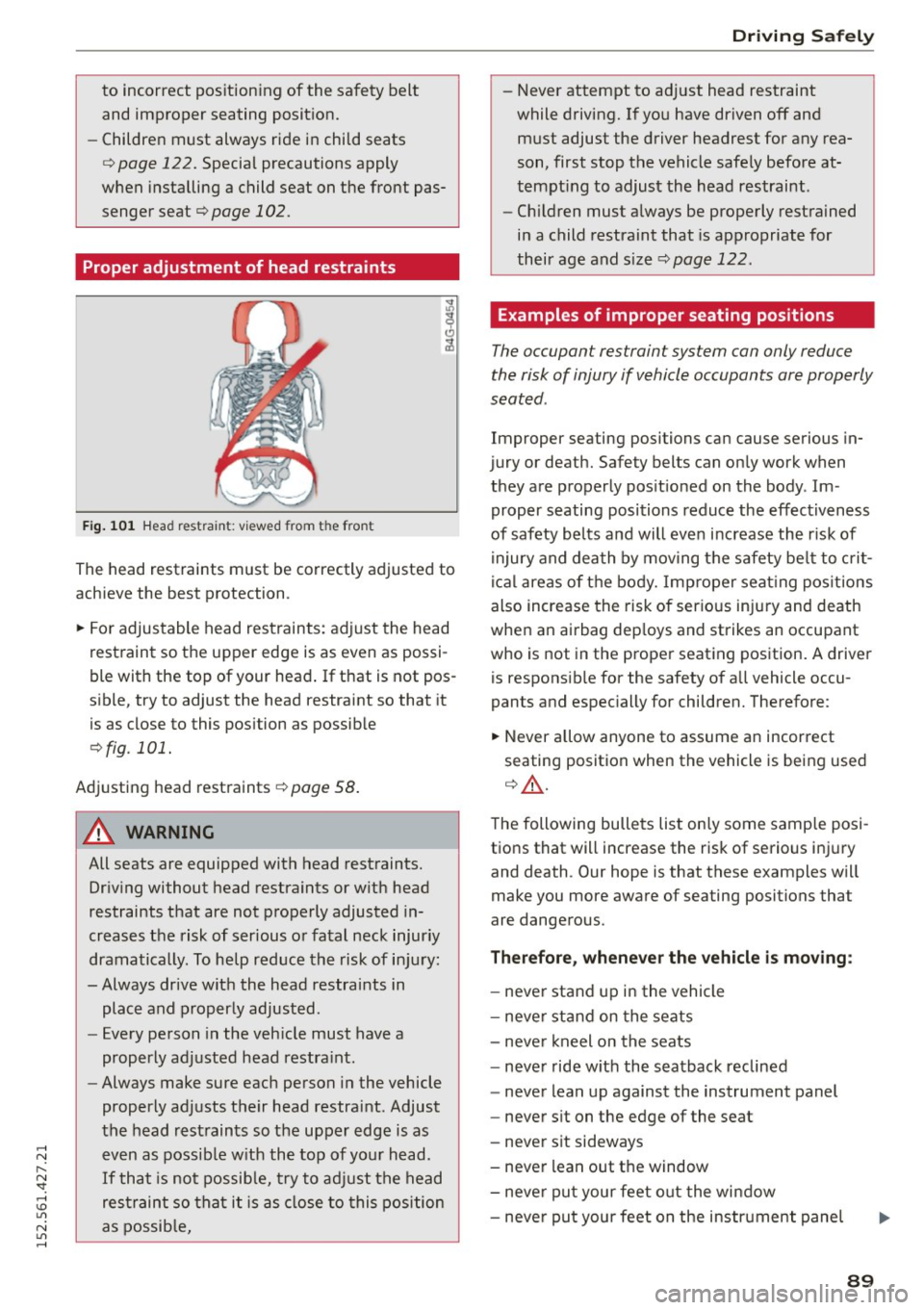
..... N
r--N "': ..... \!) ..,.,
N ..,., .....
to incorrect position ing of the sa fety belt
and improper seating posit ion.
- Children must always ride in child seats
<=> page 122. Special precautions apply
when installing a child seat on the front pas
senger seat
<=> page 102.
Proper adjustment of head restraints
Fig . 101 H ea d re str ain t: v ie w ed fro m the front
The head restraints must be correctly adjusted to
achieve the best protection .
.. Fo r adjustable head restraints: adj ust the head
restraint so the upper edge is as even as possi
ble with the top of your head. If that is not pos
sible, t ry to adjust the head restraint so that it
is as close to this pos ition as possib le
<=> fig . 101.
Adj usting head restraints<=> page 58.
&_ WARNING
All seats are equipped with head restraints.
Dr iv ing without head restraints or w ith head
restraints that are not properly adjusted in
creases the risk of serious or fatal neck injuriy
dramatically . To help reduce the risk of inju ry:
- Always drive with the head restraints in place and properly adjusted .
- Every person in the veh icle must have a
properly ad justed head restra int.
- Always make sure each person in the vehicle
properly adjusts their head restraint. Adjust
the head rest raints so the upper edge is as
even as possib le w ith the top of you r head .
If that is not possib le, try to ad just the head
res traint so that it is as close to this position
as possib le,
Dr iving Sa fel y
-Never attempt to adjust head restraint
while driving. If you have driven off and
must adjust the driver headrest for any rea
son, first stop the vehicle safe ly before at
tempt ing to adjust the head restraint .
- Ch ildren must a lways be properly restrained
in a child restraint that is appropriate for
their age and size <=>
page 122 .
Examples of improper seating positions
The occupan t res traint sys tem can only reduce
the risk of injury if vehicle occupants are properly
seated .
Improper seating positions can cause serious in
jury or death. Safety belts can on ly work when
they are properly pos it ioned on the body . Im
proper seating positions reduce the effectiveness
of safety be lts and will eve n increase the r isk of
i njury and dea th by mov ing the safety be lt to c rit
ical areas of the body. Imp roper seat ing pos itions
also increase the risk of serio us injury and death
when an airbag dep loys and strikes an occupant
who is not in the prope r seat ing pos ition. A driver
is respons ible for the safety of a ll vehicle occu
pan ts and espec ially for children. Therefore :
.. Never allow anyone to assume an incorrect
seating position when the vehicle is being used
Q &. -
The following bullets lis t on ly some samp le posi
tions that will increase the risk of serious inj ury
and death . Our hope is that these examples will
make you more aware of seating positions that
are dangerous .
Therefore, whene ver the vehicle is movi ng:
-never stand up i n the vehicle
- never stand on the seats
- neve r kneel on the seats
- neve r ride w ith the seatback reclined
- never lean up against the instrument panel
- never s it on the edge of the seat
- never sit sideways
- never lean out the window
- never put your feet o ut the window
- neve r put your feet on the instrument pane l
89
Page 92 of 232
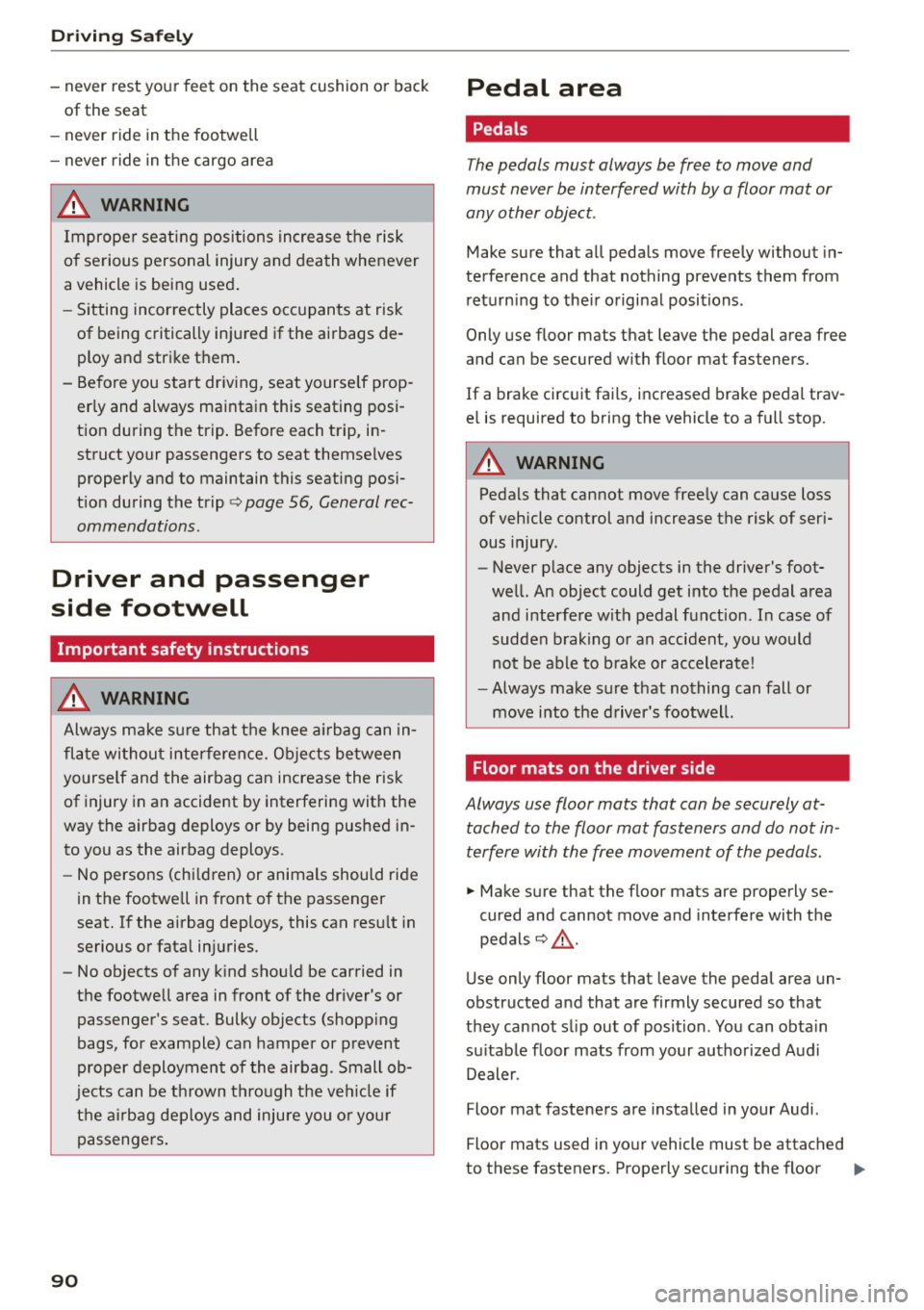
Driving Sa fel y
-never rest you r feet on the seat cushion or back
of the seat
- never ride in the footwell
- never ride in the cargo area
_& WARNING
Imprope r seating positions increase the risk
o f serious personal injury and death whenever
a vehicle is being used .
- Sitting incor rectly places occ upants at risk
of being critically in jured if the airbags de
ploy and str ike them.
- Be fore you start dr iv ing, seat yourself prop
erly and always maintain this seating posi
t ion during the trip . Before each trip, in
struct your passengers to seat themselves
properly and to maintain this seating posi
t ion during the trip
c> page 56 , General rec
ommendations .
Driver and passenger
side footwell
Important safety instructions
_& WARNING
Always make su re that the knee a irbag can in
flate wi thout interferen ce. Ob je cts betwee n
yourself and the airbag can increase the risk
of injury in an accident by interfering with the
way the airbag deploys or by being pushed in
to you as the airbag deploys.
- No persons (chi ld ren) or animals should ride
in the footwe ll in front of the passenger
seat. If the airbag dep loys, this can res ult in
serious or fatal in ju ries.
- No objects of any kind shou ld be carried in
the footwell area in front of the driver's or passenger's seat. Bulky objects (shopp ing
bags, for example) can hamper or p revent
proper deployment of the airbag . Small ob
jects can be th rown t hrough the ve hicle if
the ai rbag deploys and injure you o r you r
passengers.
90
Pedal area
' Pedals
T he pedals must always be free to move and
must never be interfered with by a floor mat or
any other object.
Make sure that all peda ls move free ly without in
terference and that nothing prevents them from
r et urning to the ir origi nal positions .
Only use floor mats that leave the pedal area free
and can be secured with floor mat fas teners.
If a brake circ uit fai ls, increased brake pedal trav
el is required to bring the vehicle to a full stop .
_& WARNING
Pedals that cannot move freely can cause loss
of vehicle control and increase the risk of ser i
ous injury .
- Never p lace any objects in the driver's foot
wel l. An object could get into the pedal area
and i nterfere with pedal function. In case of
sudden b raking o r an accident, you would
not be able to b rake or ac celerate!
- Always ma ke sure that no thing can fall or
move into the d river's footwel l.
Floor mats on the driver side
Always use floor mats that can be securely at
tached to the floor mat fasteners and do not in
terfere with the free movement of the pedals.
.. Make sure that the floor mats are properly se
cured and cannot move and interfere with the
pedals
c> ,&. .
Use only floor mats that leave the pedal area un
obstructed a nd that are firmly secured so that
they cannot s lip out of position . You can obta in
su itab le floor mats from your authorized Audi
Dealer .
Floor mat fasteners are insta lled in your Audi.
Floor mats used in yo ur vehicle must be attached
to these fasteners. Properly sec uring the floor ..,_
Page 93 of 232
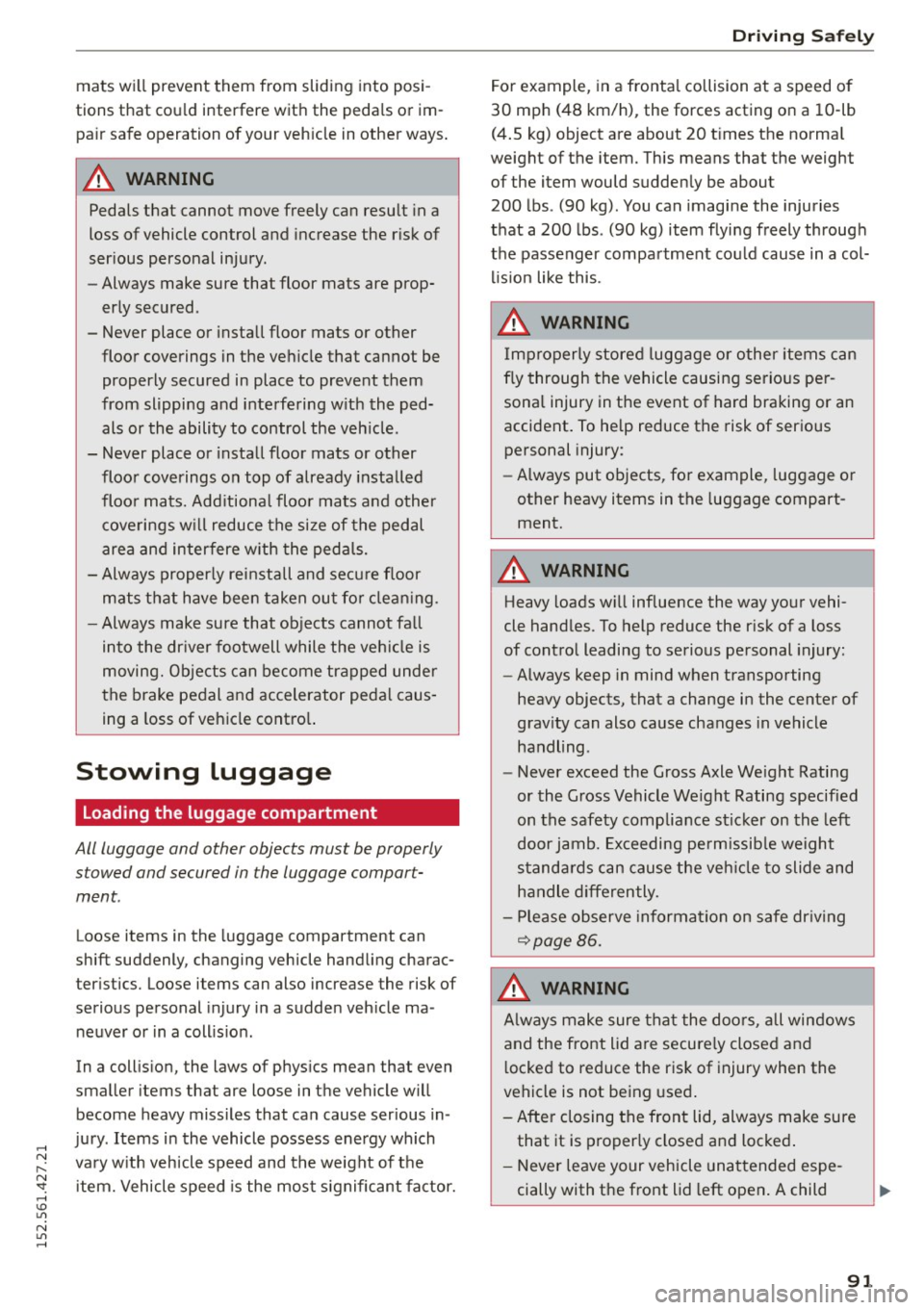
..... N
r-N "': ..... \!) ..,.,
N ..,., .....
mats wi ll prevent them from sliding into posi
tions that cou ld interfere wit h the peda ls or im
pa ir safe operation of your veh icle in other ways .
A WARNING
Pedals that cannot move freely can result in a
loss of vehicle control and increase the r isk of
ser ious personal injury.
- Always make sure that floor mats are prop
erly secured .
- Never place or insta ll floor mats or other
floor coverings in the veh icle that cannot be
properly secured in place to prevent them
from slipping and interfering w ith the ped
als or the ability to control the veh icle.
- Never place or install floor mats or other
floor coverings on top of already installed
floo r mats. Add itiona l floo r mats and other
cove rings w ill reduce the si ze of the pedal
area and interfere w ith the ped als.
- Always properly reinstall and se cu re f loor
m ats that have been taken ou t for clean ing .
- Always make sure that objects cannot fall
into the dr iver footwell while the vehicle is
moving. Objects can become tr apped under
the brake pedal and accelerator peda l caus
ing a loss of vehicle contro l.
Stowing luggage
Loading the luggage compartment
All luggage and other objects must be properly
stowed and secured in the luggage compart
ment .
Loose items in the luggage compartment can
shift suddenly, changing vehicle handling charac
ter istics. Loose items can also increase the risk of
serious personal injury in a sudden veh icle ma
neuver or in a coll is ion.
In a collis ion, the laws of p hys ics mean that even
smal ler items that are loose in the vehicle will
become heavy miss iles that can cause ser ious in
jury . Items in the vehicle possess energy which
va ry w ith vehicle speed and the we ight of the
item. Vehicle speed is the mos t significant fa ctor.
Dr iving Sa fel y
For example, in a frontal collision at a speed o f
30 mp h (48 km/h) , the forces acting o n a 10-lb
(4 .5 kg) object are about 20 t imes the norma l
weight of the item. This means that the weight of the item would sudden ly be about
200 lbs . (90 kg) . You can imagine the injuries
that a 200 lbs. (90 kg) item flyi ng freely throug h
the passeng er compartment co uld cause in a col
li sion like this.
A WARNING
Imp roperly store d luggage or other items c an
fly through the vehicle causing serio us pe r
sonal injury in the event of hard braking or an
accident . To help reduce the risk of ser ious
personal injury:
- Always put o bjects, fo r example, luggage o r
other heavy items in the luggage compart
ment.
A WARNING
Heavy loads w ill influence the way yo ur vehi
cle hand les . To help reduce the r isk of a loss
of contro l leading to serious pe rsonal injury:
- Always keep in mind when transporting
heavy objects , that a change in the center of
grav ity can also cause changes in vehicle
handling .
- Never exceed the Gross Axle We ight Rating
or the G ross Vehicle We ight Rating specified
on the safety compliance stic ker on the left
door jamb. Exceeding pe rm issib le weight
s ta nd ards c an cause the veh icle to slide and
h a ndle differently.
- Please observe informa tion on safe dr iving
~page 86.
A WARNING
Always make sure that the doo rs, all windows
and the front lid a re secure ly close d and
l ocke d to reduce the r isk of injury when the
vehicle is not be ing used .
- Afte r closing the front lid, always make sure
that it is proper ly closed and locked .
- Never leave your vehicle una ttended espe
cially with the f ront lid left open . A child
-
91
Page 94 of 232
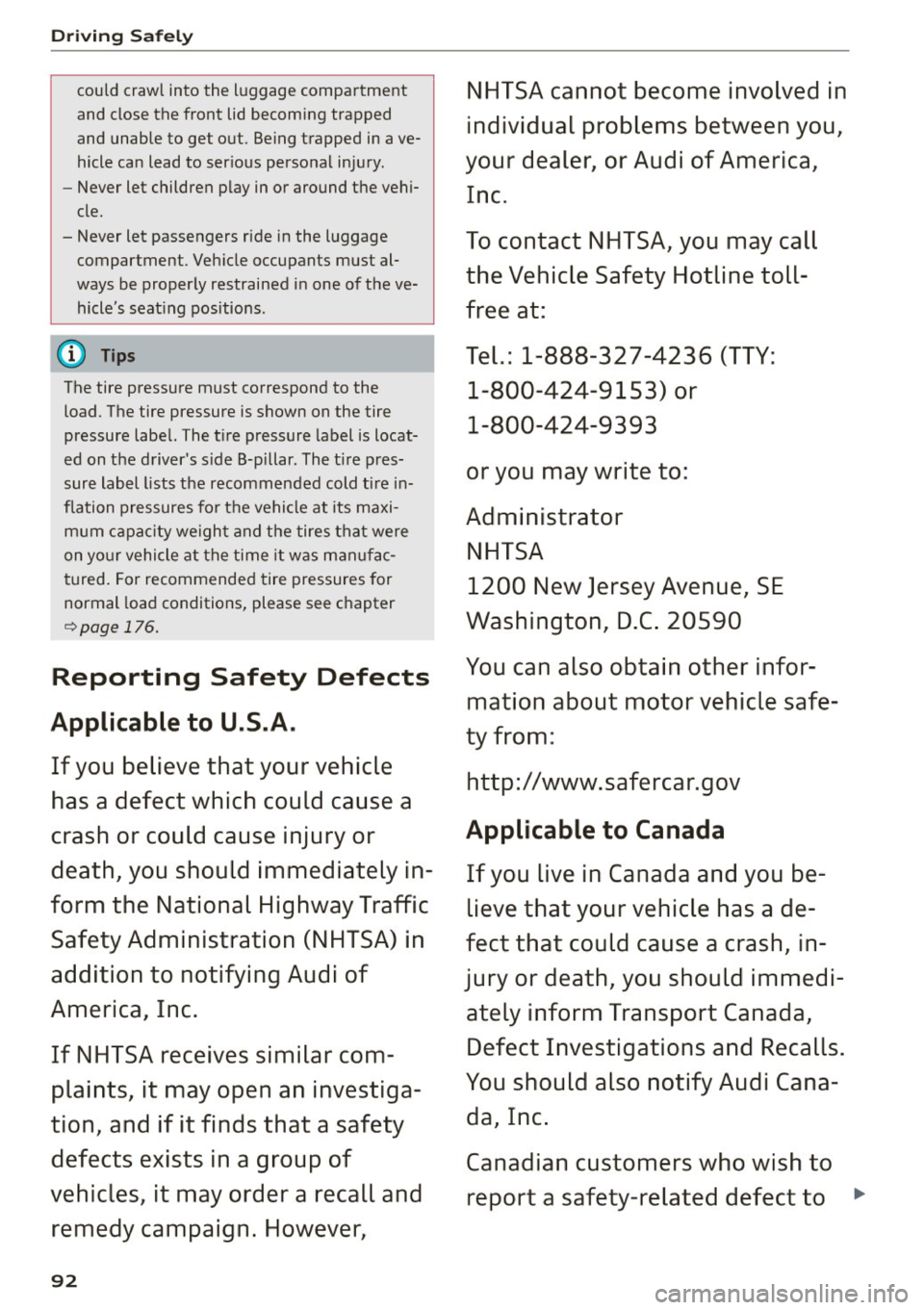
Driving Sa fel y
could crawl into the l uggage compartment
and close the front lid becoming trapped and unable to get out. Being trapped in ave
hicle can lead to ser ious personal injury.
- Never let children p lay in or around the vehi
cle.
- Never let passengers ride in the luggage compartment. Veh icle occupants must al
ways be proper ly restrained in one of the
ve
hicle's seat ing positions .
@ Tips
The tire pressure must correspond to the
load . The tire pressure is shown on the tire
pressure labe l. The t ire pressure label is locat
ed on the d river's s ide B-pillar . The t ire p res
sure label lists the recommended cold ti re in
flation pressures for t he ve hicle at its ma xi
m um c apaci ty weigh t and the tires t hat were
on yo ur vehicle at the time it w as m anuf ac
tured . For recommende d tire pressures for
normal load conditions, please see chapter
¢ page 176.
Reporting Safety Defects
Applicable to U.S.A.
If you belie ve that your vehicle
ha s a defect which could cause a
crash or could cau se injury or
death, you should immediatel y in
form the National Highwa y Tr affic
Safet y Admini stration (NHTSA) in
addition to notif ying Audi of
America, Inc.
If NHTSA re ceiv e s similar com
plaint s, it ma y op en an in vestiga
tion , and if it finds that a safe ty
def ects exis ts i n a group of
vehicle s, it may order a re call and
reme dy campaign. However,
92
NHTSA cannot b ecome in vol ve d in
indi vidual p roblems bet ween you,
y o ur deal er, or Audi of Am eric a,
In c.
To contact NHTSA, you may c all
the Vehicle Safety Hotline toll
free at:
Tel.: 1-888-327-4236 (TTY :
1-800-424-915 3) or
1-800-424-9393
o r you m ay wri te to :
Admini strator
NHTSA 1200 New Jersey A venue, SE
Wa shington, D.C. 20590
You can also obtain other infor
mation about m otor vehi cle safe
t y fr om :
http: //w ww.safercar.gov
Applicable to Canada
If you live in Canada and you be
lie ve that your vehicle has a de
fect that could cause a crash , in
j ur y or death, you should immedi
atel y inform Transport Canada,
Defect In vestigations and Recall s.
You should also notify Au di C an a
da, Inc.
Can adian cu stomer s who wi sh to
r e po rt a s afet y-related defe ct to ..,.
Page 95 of 232

...... N
l'
N "1: ...... I.O
"' N
"' ......
Transport Canada, D efect Inve sti
gation s and R ecalls, ma y either
call Tran sport Canada toll-free at:
Tel.: 1-800-333-0510 or
Tel.: 1 -819-994-3328 (Ottawa re
g ion and from other countries)
TTY for hearing impaired: Tel.:
1-888-6
7 5-6863
or contact Transport Canada by
mail at:
Transport Canada Motor Vehi cle Safety Investiga
tion s Laboratory
80 Noel Street
Gatineau, QC
J8Z 0Al
For additional road safety infor
mation, please visit the Road
Safety website at :
http ://www . tc .gc. ca/ e ng/
roadsafety/menu .htm
Driving Sa fely
Active rollover
protection system
Function
T he a ctive r ollover pro tec tion system hel ps pro
tec t vehi cle o ccup an ts in the even t of a rollover .
Fig. 102 Rollbar de ploy men t ran ge
Fig. 103 Rollb ar dep loye d
( ~ I,- ~ ~-1 . '
' . • • • • •• . '
The active ro llover protection system consists of :
- two ro llb ars
- t he sa fe ty bel ts wi th bel t t ensioner s
- t he wi ndsh ield frame
- the ro llov er se nsors .
The active roll over protection system provides
addi tional safety in the event of a r ollover . Within
milliseco nds, sensors d ep loy two rollbars located
behin d the hea drests
~fig . 10 3.
The roll bars , reinforced windshie ld frame and
belt tensioners he lp protect veh icle occupants in
the eve nt of a rollover .
The rollover protection system f unct ions when
the convertible top is both open and closed .
93
Page 96 of 232
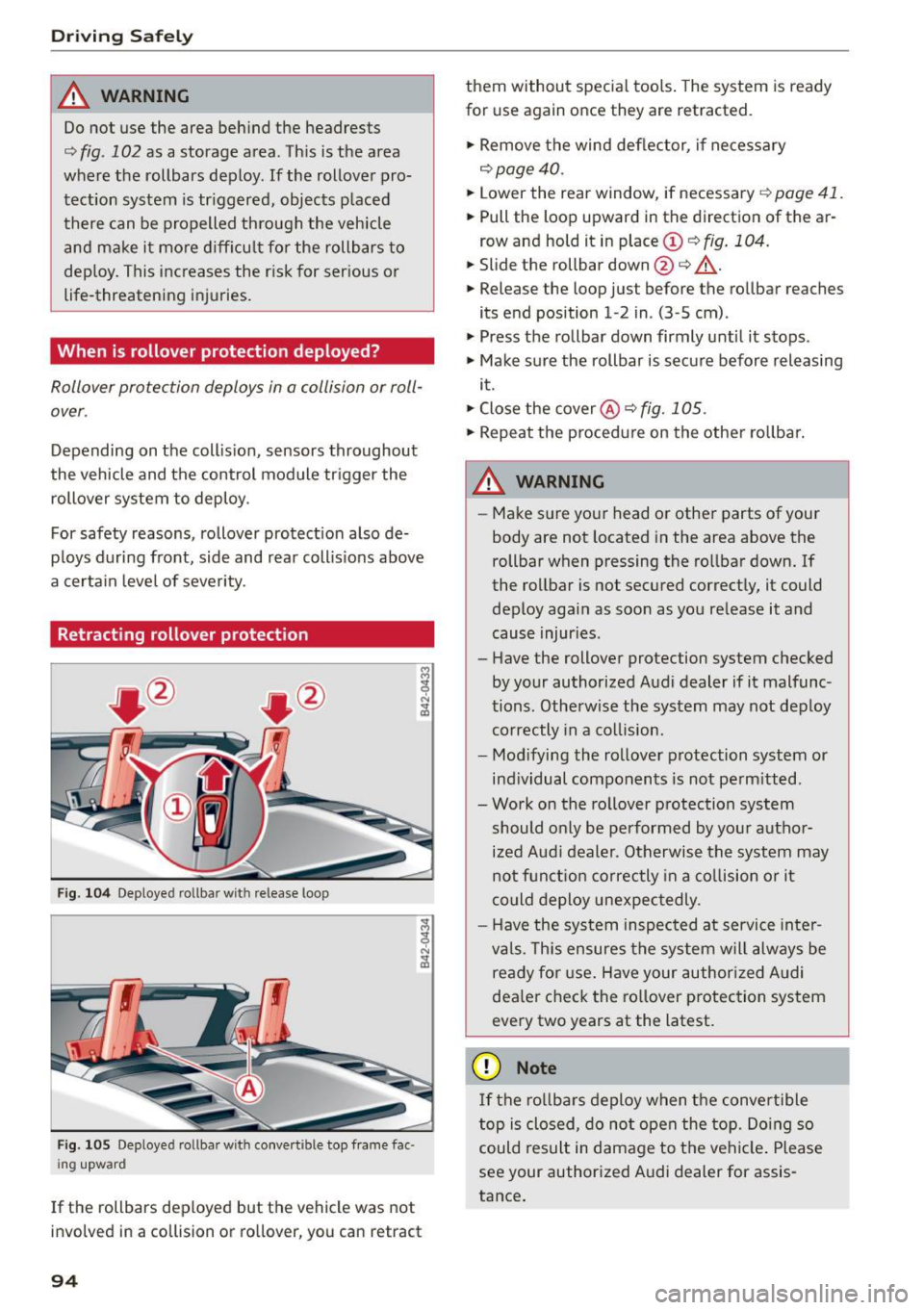
Driving Safely
_&. WARNING
Do not use the area behind the headrests
<=.> fig. 102 as a storage area . This is the area
where the rollbars deploy. If the rollover pro
tection system is triggered, objects placed
there can be propelled through the vehicle
and make it more difficult for the rollbars to
deploy. This increases the risk for serious or
life-threatening injuries.
When is rollover protection deployed?
Rollover protection deploys in a collision or roll
over .
Depending on the collision, sensors throughout
the vehicle and the control module trigger the
rollover system to deploy .
For safety reasons, rollover protection also de
ploys during front, side and rear collisions above
a certain level of severity .
Retracting rollover protection
Fig. 104 Deployed ro llbar wit h release loop
Fig. 105 Deploye d ro llbar wit h convert ib le top frame fac·
ing upward
M
M
9 N
~
If the rollbars deployed but the vehicle was not
involved in a collision or rollover, you can retract
94
them without special tools. The system is ready
for use again once they are retracted.
.,. Remove the wind deflector, if necessary
<=.>page 40 .
.,. Lower the rear window, if necessary Q page 41 .
.,. Pull the loop upward in the direction of the ar
row and hold it in place
(D r=.> fig. 104.
.,. Slide the rollbar down@¢.,&. .
.,. Release the loop just before the rollbar reaches
its end position 1 -2 in . (3-5 cm) .
.,. Press the rollbar down firmly until it stops.
.,. Make sure the rollbar is secure before releasing
it.
.,. Close the cover @
Q fig. 105.
.,. Repeat the procedure on the other rollbar.
& WARNING
-
-Make sure your head or other parts of your
body are not located in the area above the
rollbar when pressing the rollbar down. If
the rollbar is not secured correctly, it could deploy again as soon as you release it and
cause injuries .
- Have the rollover protection system checked
by your authorized Audi dealer if it malfunc
tions. Otherwise the system may not deploy correctly in a collision .
- Modifying the rollover protection system or
individual components is not permitted.
- Work on the rollover protection system
should only be performed by your author
ized Audi dealer . Otherwise the system may
not function correctly in a collision or it
could deploy unexpectedly .
- Have the system inspected at service inter
vals. This ensures the system will always be
ready for use. Have your authorized Audi
dealer check the rollover protection system
every two years at the latest.
(D Note
If the rollbars deploy when the convertible
top is closed, do not open the top. Doing so
could result in damage to the vehicle. Please
see your authorized Audi dealer for assis
tance.
Page 97 of 232
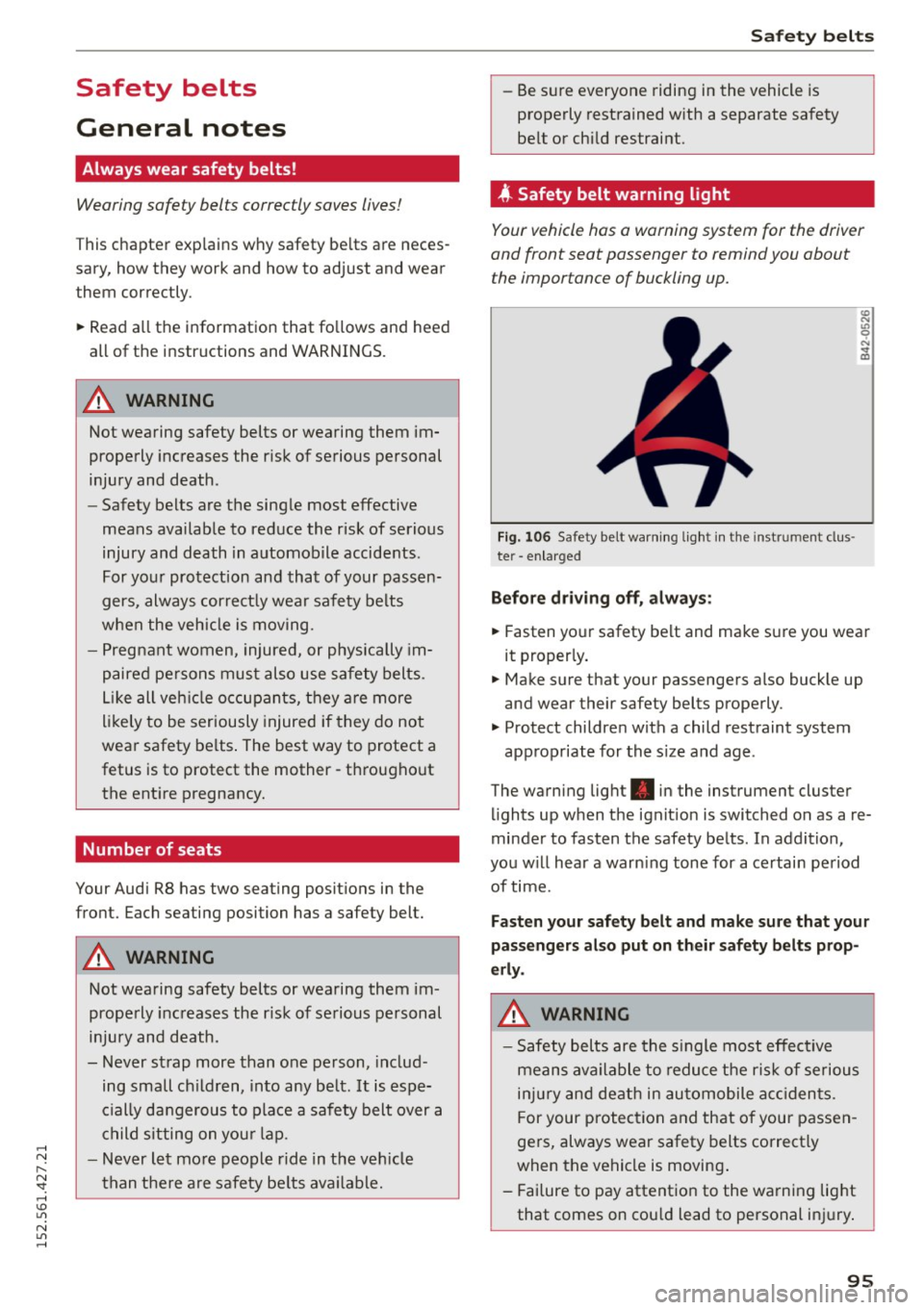
..... N
r-N "': ..... \!) 1.1"1
N
"' .....
Safety belts
General notes
Always wear safety belts!
Wearing safety belts correctly saves lives !
This chapte r exp lains why safety be lts are neces
sary, how they work and how to adjust and wear
them correctly .
.. Read a ll the informat ion that fo llows and heed
all of the instructions and WARNINGS .
A WARNING
Not wearing safety belts or wearing them im
prope rly i ncreases the r isk of serious personal
injury and death.
- Safety belts are the sing le most effective
means availab le to red uce the r isk of serious
injury and death in automobile accide nts .
For yo ur protection and tha t of your passen
gers, always corre ct ly wear safety belts
w hen the veh icle is moving.
- P re g nant women, injured, or physically im
paired pe rso ns mu st also use safety belts .
Lik e all ve hicle occupants, t hey are more
likely to be seriously injured if they do no t
wea r safety be lts . The best way to protect a
fetus is to protect the mother -th rougho ut
the enti re pregnancy.
Number of seats
Your Audi R8 has two seating posit ions in the
front. Each seating position has a safety belt.
A WARNING
Not wearing safety belts or wearing them im
prope rly i ncreases the risk of se rious personal
injury and death.
- Never st rap more than one person, includ
ing small ch ildren, into any belt .
It is espe
c ially da ngerous to place a safety belt over a
c hild sitting on you r lap.
- Never let mo re people ride in the ve hicle
t h an t he re are safety be lts ava ilable.
Sa fety bel ts
- Be s ure everyone riding in the vehicle is
properly restrained w ith a separate sa fety
be lt or chi ld restraint.
4 Safety belt warning light
Your vehicle hos o warning system for the driver
and front seat passenger to remind you about the impor tance of buckling up.
Fig . 1 06 Safety bel t wa rning lig ht in the instr ument clus
te r - en lar ged
Before dr iving off, alway s:
"' m
.. Fasten yo ur safety belt and make s ure you wea r
it properly .
.,. Make sure that your passengers also buck le up
and wear their safety belts properly .
.,. Protect childre n with a child restraint system
app ropriate for the s ize and age .
The warning lig ht . in the instrument cluster
li ghts up when the ign it ion is switched on as a re
minder to fasten the safety be lts . In addi tion ,
you w ill hear a warn ing tone for a certai n pe riod
of time.
Fasten your safety belt and make sure that your
passengers al so put on their safety belts prop
erly .
A WARNING
-Safety belts are the s ingle most effective
mean s ava ilable to reduce t he r is k o f seriou s
in jur y and de ath in au tom obile acc iden ts.
F or your protec tion and that of your passen
ge rs, always wear safety belts correct ly
when the vehicle is moving .
- Fai lure to pay attent io n to the warni ng lig ht
that comes on cou ld lead to personal in jury.
-
95
Page 98 of 232
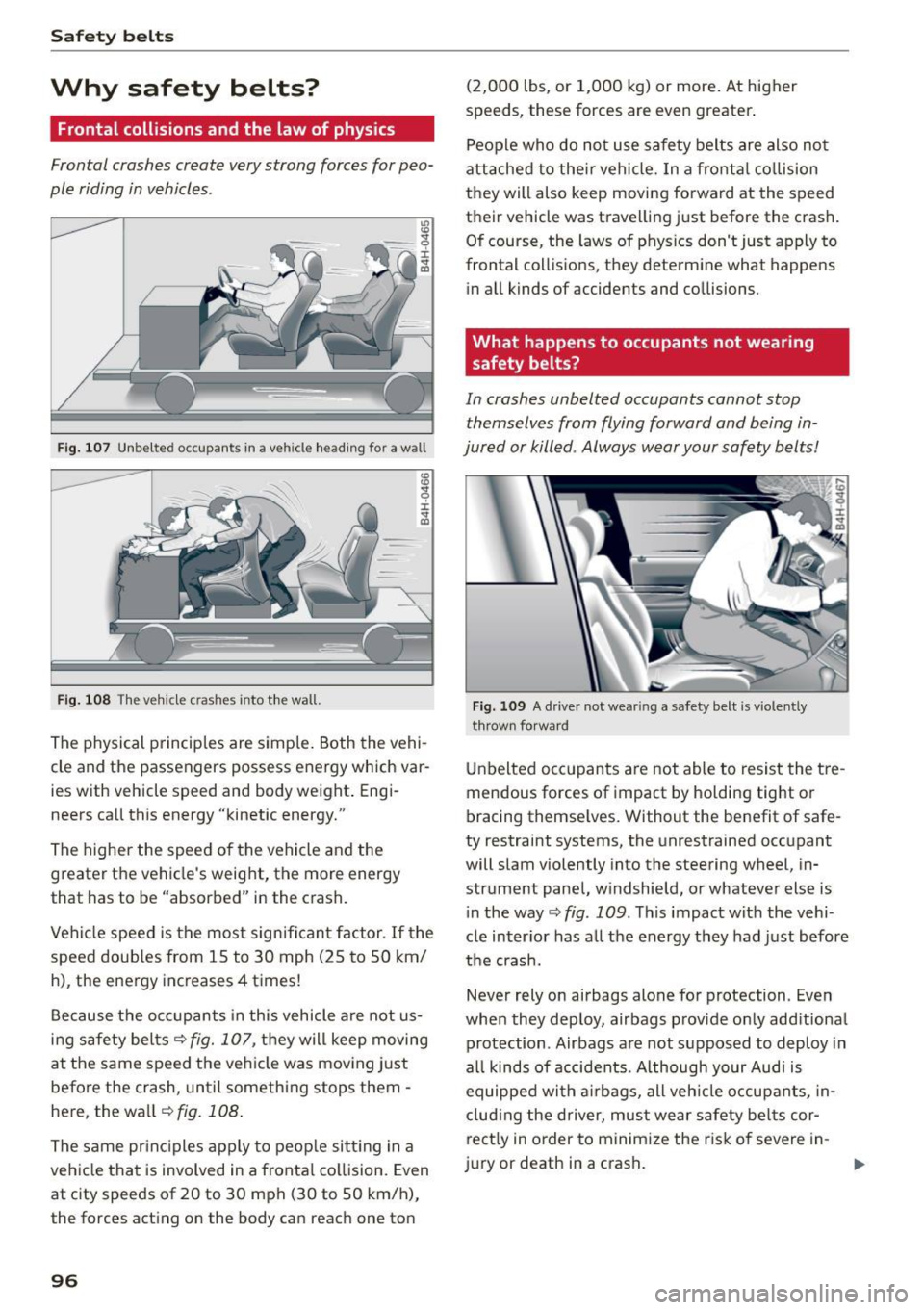
Safety belts
Why safety belts?
Frontal collisions and the law of physics
Frontal crashes create very strong forces for peo
ple riding in vehicles .
Fig. 107 Unbelted occupants in a veh icle heading for a wall
Fig. 108 The vehicle c rashes into the wall.
The physical principles are simple. Both the vehi
cle and the passengers possess energy which var
ies w ith vehicle speed and body weight . Engi
neers call this energy "kinetic energy."
The higher the speed of the vehicle and the
greater the vehicle's weight, the more energy
that has to be "absorbed" in the crash.
Vehicle speed is the most significant factor. If the
speed doubles from 15 to 30 mph (25 to 50 km/
h), the energy increases 4 times!
Because the occupants in this vehicle are not us
ing safety belts
c::> fig. 107, they will keep moving
at the same speed the vehicle was moving just
before the crash, until something stops them -
here, the wall
¢ fig. 108 .
The same principles apply to people sitting in a
vehicle that is involved in a frontal collision. Even
at c ity speeds of 20 to 30 mph (30 to SO km/h),
the forces acting on the body can reach one ton
96
(2,000 lbs, or 1,000 kg) or more. At higher
speeds, these forces are even greater.
People who do not use safety belts are also not
attached to their vehicle. In a frontal collision
they will also keep moving forward at the speed
their vehicle was travelling just before the crash.
Of course, the laws of phys ics don't just apply to
frontal collis ions, they determine what happens
in all kinds of accidents and collisions.
What happens to occupants not wearing
safety belts?
In crashes unbelted occupants cannot stop
themselves from flying forward and being in
jured or killed . Always wear your safety belts!
Fig. 109 A drive r not wea ring a safety belt is v io lently
t hrown forward
Unbelted occupants are not able to resist the tre
mendous forces of impact by holding tight or
bracing themselves. Without the benefit of safe
ty restraint systems, the unrestrained occupant
will slam violently into the steering wheel, in
strument panel, w indshield, or whatever else is
i n the way
c::> fig . 109 . This impact with the vehi
cle inter ior has all the energy they had just before
the crash.
Never rely on airbags alone for protection. Even
when they deploy, airbags provide only add itional
protection . Airbags are not supposed to deploy in
all kinds of accidents . Although your Audi is
equipped with airbags, all vehicle occupants, in
cluding the driver, must wear safety belts cor
rect ly in order to minimize the r isk of severe in-
jury or death in a c rash.
ll-
Page 99 of 232
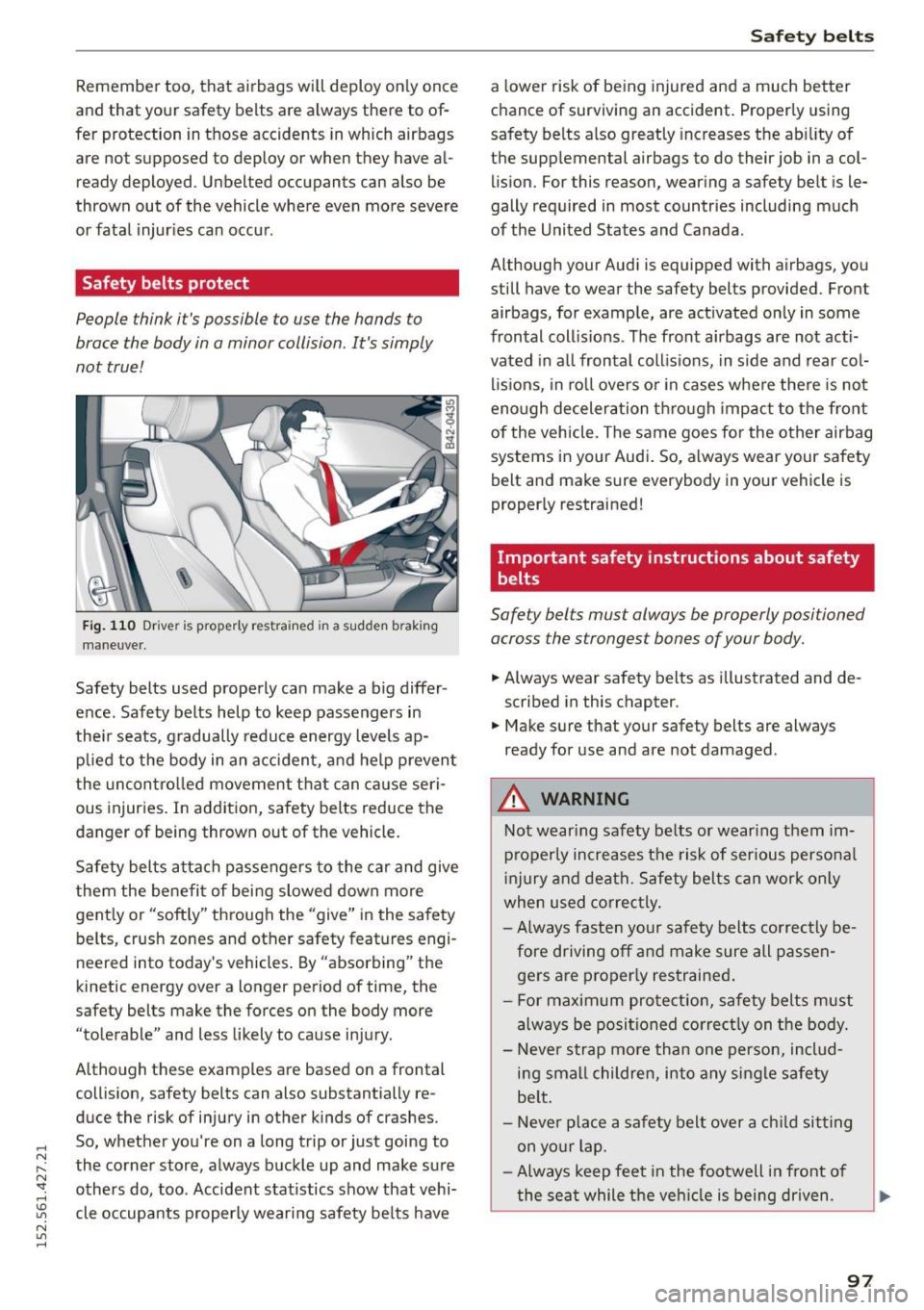
.... N
l'
N "1: .... I.O
"' N
"' ....
Remember too, that airbags will deploy only once
and that your safety belts are always there to of
fer protection in those accidents in which airbags
are not supposed to deploy or when they have al ready deployed . Unbelted occupants can also be
thrown out of the vehicle where even more severe
or fatal injuries can occur .
Safety belts protect
People think it's possible to use the hands to
brace the body in a minor collision . It 's simply
not true!
Fig. 110 Dr ive r is properly restrained in a sudden b raking
maneuver.
Safety belts used properly can make a big differ
ence. Safety belts help to keep passengers in
the ir seats, gradually reduce energy levels ap
plied to the body in an accident, and help prevent
the uncontro lled movement that can cause seri
ous injuries. In addition, safety belts reduce the
danger of being thrown out of the vehicle.
Safety belts attach passengers to the car and give
them the benefit of being slowed down more
gently or "softly '' through the "give" in the safety
belts, crush zones and other safety features engi
neered into today's vehicles . By "absorbing" the
kinetic energy over a longer period of time, the
safety belts make the forces on the body more
"tolerable" and less likely to cause injury.
Although these examples are based on a frontal collision, safety belts can also substantially re
duce the risk of injury in other kinds of crashes .
So, whether you're on a long trip or just going to
the corner store, always buckle up and make sure others do, too. Accident stat istics show that vehi
cle occupants properly wearing safety be lts have
Safety belts
a lower risk of being injured and a much better
chance of surviving an accident. Properly using
safety belts also greatly increases the ability of
the supp lemental airbags to do their job in a col
lision. For this reason., wearing a safety belt is le
gally required in most countries including much
of the United States and Canada.
Although your Audi is equipped with airbags, you
still have to wear the safety belts provided. Front airbags, for example, are activated only in some
frontal coll isions. The front airbags are not acti
vated in all frontal collisions, in side and rear col
lisions, in roll overs or in cases where there is not
enough deceleration through impact to the front
of the vehicle. The same goes for the other airbag
systems in your Audi . So, always wear your safety
belt and make sure everybody in your vehicle is
properly restrained!
Important safety instructions about safety
belts
Safety belts must always be properly positioned
across the strongest bones of your body.
• Always wear safety belts as illustrated and de
scribed in this chapter.
• Make sure that your safety belts are always
ready for use and are not damaged.
A WARNING
-Not wearing safety belts or wearing them im-
properly increases the risk of ser ious personal
in jury and death. Safety belts can work only
when used correctly.
- Always fasten your safety belts correctly be
fore driving off and make sure all passen
gers are properly restrained .
- For maximum protection, safety belts must
always be positioned correctly on the body.
- Never strap more than one person, includ
i ng smal l children, into any single safety
be lt.
- Never plac e a safety belt over a child sitting
on your lap .
- Always keep feet in the footwell in front of
the seat while the vehicle is being driven .
97
Page 100 of 232
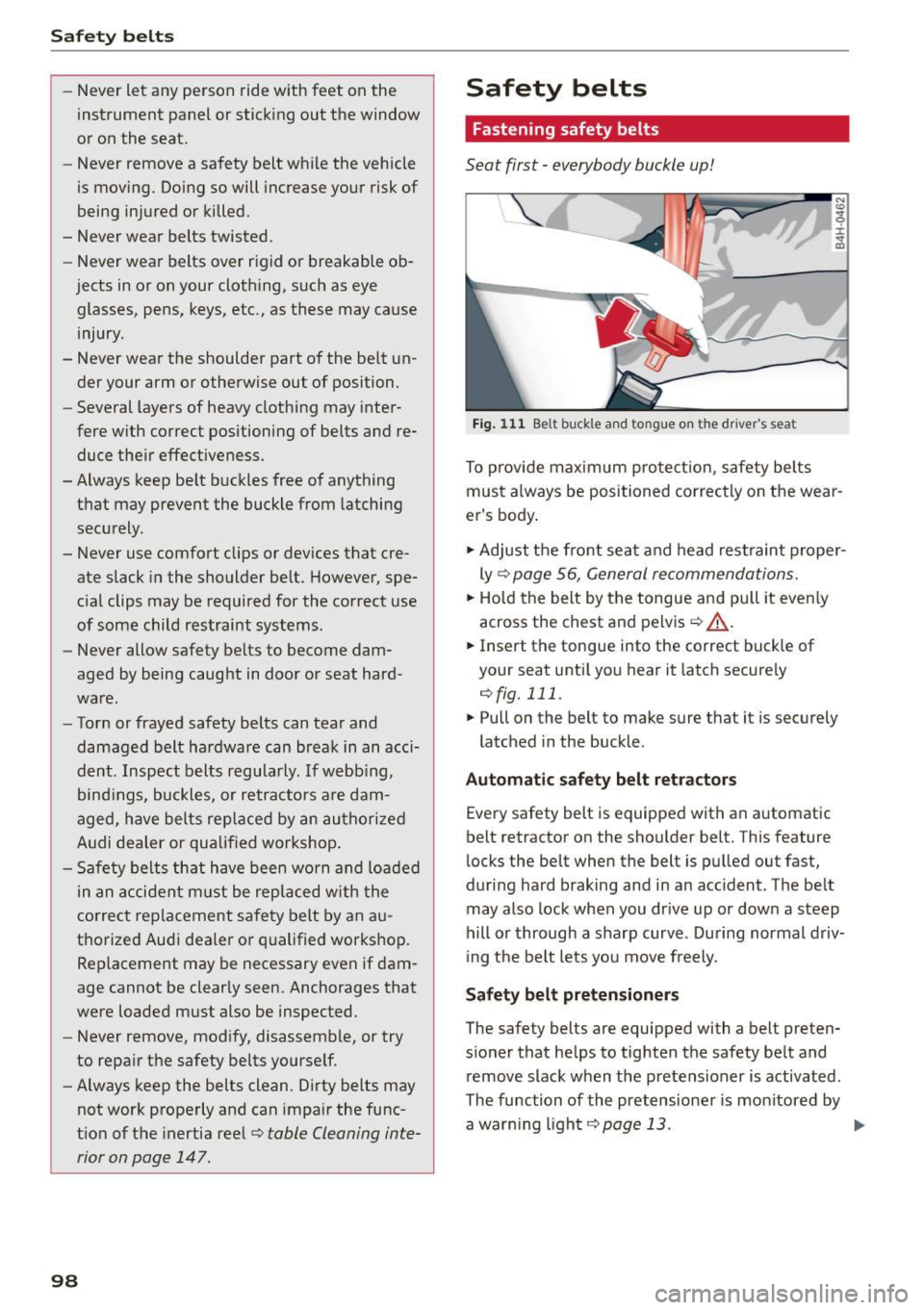
Safety belts
-Never let any person ride with feet on the
instrument panel or stick ing out t he window
or o n the seat.
- Never remove a safety belt while the vehicle
is mov ing . Do ing so will increase your risk of
being injured or killed.
- Never wear belts twisted .
- Never wea r belts over rigid or breakable ob-
jects in or on your cloth ing, such as eye
glasses, pens, keys, etc., as these may ca use
injury.
- Never wear the shoulder part of the be lt un
der your arm or otherwise out of position .
- Several layers of heavy clothing may inter
fere w ith correct positioning of belts and re
duce the ir effectiveness.
- Always keep be lt b uckles free of anything
that may prevent the buckle from latching
sec urely .
- Never use comfort clips or devices that cre
ate slack in the shoulder belt. However, spe
c ial clips may be required for the corr ect use
of some chi ld restraint systems .
- Never allow safety be lts to become dam
aged by being caught in doo r or seat hard
ware .
- Torn or frayed safety belts can tear and
damaged belt hardware can break in an acci
dent . Inspect belts r egularly. If webb ing,
bind ings, buckles, or re tractors a re dam
aged, have belts rep laced by an au thori zed
Audi dealer or qua lified workshop .
- Safe ty belts that have been worn and l oad ed
in an accident m ust be repl aced w ith the
c orrect rep lacement sa fety belt by an a u
t h orize d Aud i dea le r o r q ualified wor ksh o p.
Replacement may be necessary even if dam
age cannot be clear ly seen. Anchorages that
were loaded must also be inspected .
- Never remove, mod ify, disassemble, or try
to repa ir the safety belts yourse lf.
- Always keep the belts clean. D irty belts may
not work properly and can impa ir the func
t ion of the inertia ree l
¢table Cleaning inte
rior on page 147.
98
Safety belts
Fastening safety belts
Seat firs t -everybody buckle up!
Fig. 1 11 Be lt buc kle a nd to ngue o n the drive r's seat
N
CD
~ ::i: .. a,
To p rovi de maximum pro tect ion , safety bel ts
must a lways be positioned correc tly on t he wear
er 's body .
., Ad just the fro nt sea t and head res traint p roper
ly
q page 56, General re commendations.
., Ho ld the belt by the tongue and pull it even ly
across the chest and pelvis¢&, .
., Insert th e tongue into the correct buck le of
your seat until you hear it latch secure ly
¢fig. 111.
., Pull on the belt to make sure tha t it is securely
latched in the buckle .
Automatic safe ty belt retractor s
Every safety belt is equipped with an automatic
belt retractor on the sho ulder belt. This featu re
lock s the belt when the belt is pulled out f ast ,
during h ard braking and in an acc ident . The be lt
may also lock when you dr ive up or down a steep
hill or through a sharp curve . During normal d riv
i ng the belt lets yo u move freely .
Safety belt pretensioners
The safety belts are equipped wi th a belt pre ten
s ione r that he lps to tighten the safety be lt and
remove slack when the p retens ioner is activated.
The function of the pretensione r is mon itored by
a war ning ligh t¢
page 13. ..,.